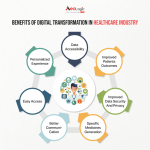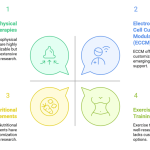Cytokinetics Unveils Innovative Presentations at HFSA Annual Scientific Meeting 2025


Modern Medicine’s Rising Role: Essential Innovations Explained
Modern medicine is an ever-evolving realm that has seen groundbreaking progress over the past few decades. Many people today marvel at the new technological developments that are completely reshaping diagnostics and treatment. In my view, advancements in the field are a must-have breakthrough that has started to change how we approach healthcare. While modern medicine shows tremendous promise, it also has its own tricky parts that require a closer look.
The current state of modern medicine is no longer confined to traditional hospital settings. New digital tools, including telemedicine and wearable technology, allow patients to monitor and manage their health like never before. This innovation is particularly useful for individuals who struggle to find their way through the maze of frequent, in-person appointments. These breakthrough ideas not only enhance patient care but also help improve the overall efficiency of the healthcare system.
Yet, as we embrace these new approaches, we must also be aware of the tangled issues surrounding privacy, cybersecurity, and data safety. While the benefits of these innovations are clear, the process of integrating them into everyday care can sometimes feel overwhelming. Many stakeholders and patients alike have to figure a path through legal regulations and ethical dilemmas, ensuring that the technology remains safe and secure for everyone involved.
Telemedicine and Digital Health: Digging Into the Future of Patient Care
Telemedicine has become a game changer, offering patients a way to connect with healthcare providers without leaving their homes. By using video calls, mobile apps, and remote monitoring devices, telemedicine simplifies the delivery of care. Even though these methods have to be carefully evaluated for their security aspects, they provide a practical solution for patients facing long distances or a shortage of local healthcare services.
There are several clear advantages to telemedicine and digital health:
- Quick access to specialist advice, even from remote areas
- Minimized waiting times, which can prove crucial in moments of urgent need
- Regular monitoring of chronic conditions from the comfort of home
- Enhanced communication between patients and healthcare practitioners
Despite these benefits, many remain cautious. The process of moving from traditional care methods to digital solutions is full of problems. Concerns about data breaches and cyberattacks make it necessary for every healthcare institution to invest actively in advanced security measures. The push toward integrating technology into health has also sparked debates among experts about how best to balance innovation with the protection of personal information.
Overall, the shift towards telemedicine represents a promising step forward. It is the start of a new era where healthcare can be not only more efficient but also more accessible to those who have previously been left behind by conventional models of care.
Alternative Medicine: Diving Into Traditional Wisdom for Modern Health Relief
Alternative medicine provides a space for exploring health remedies that extend beyond the boundaries of conventional science. Traditional practices—ranging from acupuncture to herbal treatments—offer unique benefits that many find appealing, especially when conventional medicine seems too focused on drugs or invasive procedures. Although some critics argue that these methods lack scientific support, a growing community of health advocates maintains that alternative practices can complement modern treatments in truly beneficial ways.
It is clear that many patients appreciate the more natural approach offered by alternative medicine. These treatments are often less intimidating and emphasize a holistic view of health that addresses the body, mind, and spirit collectively.
There are several subtle parts of alternative medicine that contribute to its appeal:
- Herbal Remedies: Many herbs are celebrated for their anti-inflammatory and antioxidant properties, which some studies suggest can help reduce symptoms of chronic illnesses.
- Acupuncture: This ancient practice is believed to stimulate energy flow through the body, helping to relieve pain and stress.
- Meditation and Mind-Body Techniques: Practices like mindfulness and yoga help reduce anxiety and improve overall mental well-being, making them critical to a person’s healing journey.
Critics point out that skepticism about alternative medicine can be off-putting because some practices are still riddled with tension between anecdotal evidence and clinical research. However, it is important to work through these issues by promoting further research and openly discussing the pros and cons of both alternative and modern treatment approaches.
Understanding how to blend the best features of conventional and alternative medicine might be key to developing a more comprehensive approach to health. By taking the time to compare these practices and learn from one another, patients and doctors alike can benefit from a richer, more nuanced perspective on healing.
Nutritional Insights: Key Diet Adjustments for Long-term Wellness
Nutrition is essential for maintaining overall well-being. A balanced diet remains at the core of preventing and managing many disease conditions. Although many of us are aware of the benefits of healthy eating, the confusing bits about the right mix of foods continue to perplex even the most dedicated health enthusiasts.
It is often nerve-racking to sift through conflicting dietary advice—from fad diets that promise quick fixes to traditional guidelines that sometimes seem outdated. Despite these challenges, making informed nutritional choices is critical for building a strong, resilient body capable of fighting off illnesses and staying vibrant over time.
Understanding Diet Trends: Finding Your Path Through A Sea of Information
Understanding the subtle details of modern diet trends requires careful thought and personal experimentation. The following bullet points outline some of the key considerations when designing a balanced eating plan:
- Whole Foods First: Prioritize natural, unprocessed foods that deliver a high nutrient density.
- Healthy Fats: Incorporate sources like avocado, nuts, and olive oil that support heart health and reduce inflammation.
- Lean Proteins: Choose proteins such as legumes, fish, and lean meats to aid in muscle repair and growth.
- Fiber-Rich Options: Emphasize fruits, vegetables, and whole grains to improve digestion and maintain a balanced gut microbiome.
- Hydration: Ensure sufficient water intake, which is super important for overall organ function and metabolic processes.
In addition to dietary content, meal timing and portion control stand out as key components of a successful nutritional strategy. Some experts advocate for intermittent fasting, while others promote the benefits of frequent, smaller meals to sustain energy and optimize metabolism.
All in all, it is clear that the process of figuring a path through nutritional advice is challenging. However, striking the right balance can lead to remarkable improvements in overall health, energy levels, and disease prevention.
Nutrition and Disease Management: Small Distinctions That Make a Big Impact
Nutrition does more than merely keep hunger at bay; it plays a critical role in preventing disease conditions such as diabetes, heart disease, and even certain cancers. For many patients, food is medicine—a natural, accessible way to support healing and recovery. The idea that each meal has the potential to influence health outcomes is both empowering and motivating.
A table below summarizes how specific dietary components can aid in disease management:
| Nutrient | Potential Health Benefit | Food Sources |
|---|---|---|
| Antioxidants | Help reduce oxidative stress, which can lower the risk of chronic diseases | Berries, green tea, dark chocolate |
| Omega-3 Fatty Acids | Support heart health and reduce inflammation | Fatty fish, flaxseeds, walnuts |
| Fiber | Aids in digestion and can help lower cholesterol levels | Whole grains, fruits, vegetables |
| Probiotics | Maintain a healthy gut flora, which is linked to overall immunity | Yogurt, sauerkraut, kefir |
This table can act as a quick reference for those trying to fine-tune their diets according to their personal health goals. Yet, for many individuals, it’s still necessary to work through the nerve-racking details of dietary adaptations, ensuring that portions and calorie counts are managed appropriately while still enjoying a varied and satisfying menu.
Disease Conditions: Managing Your Way Through Complex Health Challenges
Dealing with disease conditions is, without doubt, one of the most overwhelming aspects of healthcare today. Whether a chronic illness like diabetes or an acute condition like a respiratory infection, many patients find themselves facing a literal minefield of treatment options, side effects, and lifestyle changes.
One of the main challenges in disease management is pinpointing the right combination of modern treatments and lifestyle interventions. It’s not just a matter of prescribing medications; it is also about incorporating supportive measures like nutrition, physical activity, and even alternative therapies that can help when the standard care approach seems to miss some of the finer details of an individual’s needs.
Building a Comprehensive Treatment Plan: The Nitty-Gritty of Integrated Care
When managing disease conditions, a multi-pronged care approach is often the most effective. Here are some critical points to consider:
- Regular Monitoring: Keeping track of vital signs and symptoms can help adjust treatments in real time.
- Medication Management: Ensuring that prescriptions are taken as directed, while being cautious of possible interactions.
- Lifestyle Adjustments: Simple changes like diet modifications, exercise, and quitting smoking can dramatically improve outcomes.
- Emotional Support: Psychological counseling and support groups help patients stay positive even when progress seems slow.
- Alternative Therapies: Incorporating practices such as acupuncture or herbal supplements may supplement traditional treatments.
For many who face prolonged battles with illness, finding a well-rounded treatment plan involves not only working with doctors but also educating themselves about their condition. It requires figuring out a path in which the practical aspects of daily life mesh successfully with the medical interventions prescribed by healthcare providers.
A key takeaway is that the treatment process is full of little details—sometimes subtle parts—that can determine the difference between merely surviving and truly thriving. For instance, the timing of medication relative to meals can be just as important as the type of medication itself, a fact that underscores the inherent complexity in managing chronic conditions.
Empowering Patient Participation in Healthcare Decisions
The modern approach to healthcare emphasizes shared decision-making between patients and their healthcare providers. Instead of being passive recipients of care, individuals are encouraged to actively participate in their treatment planning. This interactive model creates an atmosphere where patients feel more in control, which can, in turn, improve outcomes significantly.
Several strategies can empower patients:
- Educational Workshops: Interactive sessions that explain treatment options and potential side effects.
- Support Groups: Forums where individuals share experiences and practical tips for managing health.
- Personal Health Records: Digital records that allow patients to track their symptoms, medications, and appointments.
- Regular Consultations: Frequent check-ins with healthcare providers to review treatment progress.
Engagement in these processes helps patients understand both the scope of their illness and the little twists involved in managing it effectively. While it may initially feel intimidating to question the status quo, patients soon discover that they are a key part of their own healing journey.
Fitness and Well-being: Pulse-Boosting Regimens for Better Health
Beyond treatment and diet, physical fitness remains an essential component of comprehensive healthcare. Exercise is not merely about losing weight or building muscle; it’s a crucial way to boost mood, reduce stress, and improve cardiovascular health. In today’s fast-paced world, many people find it off-putting to commit to a regular fitness routine. However, even small, consistent steps in physical activity can yield dramatic improvements in overall well-being.
Whether you are new to exercise or a seasoned athlete, it is critical to find a regimen that suits your individual needs. The fitness journey often begins with understanding your current state of health and setting achievable goals. From there, small distinctions such as the timing and type of exercise can have a significant impact.
Establishing a Sustainable Exercise Routine
Creating a workout plan that supports your health while fitting into your lifestyle is about understanding the little details that make a world of difference. Consider the following strategies when designing your routine:
- Start Small: If you’re new to exercise, even a brief daily walk can set the tone for further improvements.
- Mix It Up: Combine cardio, strength training, and flexibility exercises to ensure a balanced workout regimen.
- Listen to Your Body: Pay attention to signals of overexertion and adjust your workouts accordingly.
- Gradual Progression: Slowly increase the duration and intensity of your exercises to avoid injuries.
- Enjoyable Activities: Choose forms of exercise that you genuinely enjoy, which can range from dancing to swimming or cycling.
Table 1 below summarises different types of exercise routines and their key benefits:
| Exercise Type | Key Benefits | Examples |
|---|---|---|
| Cardiovascular | Boosts heart health, improves endurance | Walking, running, cycling |
| Strength Training | Improves muscle tone, supports bone density | Weight lifting, resistance bands, body-weight exercises |
| Flexibility & Balance | Enhances range of motion, prevents injuries | Yoga, Pilates, stretching routines |
By mixing various forms of exercise, you give your body a well-rounded workout that not only strengthens muscles but also improves coordination and flexibility. It is important to remember that the process of getting active should be enjoyable rather than seen as a chore, which helps in making the new routine a permanent fixture in your daily life.
The Psychological Impact of Regular Physical Activity
Regular exercise is equally important for mental health. Engaging in physical activities releases endorphins, the body’s natural “feel-good” chemicals, which are proven to reduce stress and alleviate symptoms of depression and anxiety. Exercising in a routine can also serve as a form of meditation, offering moments of calm in a sometimes overwhelming daily routine.
For many people, the initial step towards fitness seems daunting due to the fear of injury or the belief that their current physical state is a barrier. Yet, countless success stories confirm that no matter your starting point, even small amounts of regular movement can create lasting, beneficial changes—both physically and mentally.
Integrating a Holistic Approach: Bridging Modern and Alternative Healthcare
While modern medicine offers incredible breakthroughs and alternative medicine illuminates traditional wisdom, the future of healthcare may well lie in integrating both. Combining the strengths of advanced technology and scientifically proven treatments with the natural, holistic approaches of alternative therapies could provide a more balanced and comprehensive framework for well-being.
This merging of philosophies is full of fine points, where the finest details matter. It means working through the sometimes complicated pieces of each domain to craft a personalized health plan that addresses all aspects of wellness—physical, mental, and emotional. Many experts are beginning to advocate for this integrated model, arguing that neither modern medicine nor alternative approaches alone hold all the answers.
For example, a patient suffering from chronic pain might benefit from cutting-edge pain management techniques alongside mindfulness exercises and herbal supplements. By integrating these methods, patients can enjoy relief that targets both the physical symptoms and the underlying emotional stress that accompanies chronic conditions.
Integrative healthcare involves several key elements:
- Collaboration Among Practitioners: Medical professionals from various backgrounds work together to create comprehensive treatment plans.
- Patient-Centered Approaches: Recognizing that every patient’s needs are unique, practitioners tailor treatment strategies accordingly.
- Continuous Research: Ongoing studies help refine integrative methods, ensuring that both modern and alternative practices are grounded in evidence-based research.
This holistic model not only enhances patient care but also encourages a proactive attitude towards health, where individuals are empowered to take charge of their wellness in every possible way.
Challenges and Opportunities for Integrative Healthcare
No approach is without its challenges. Blending modern and alternative methods can be intimidating because it involves figuring a path through regulatory frameworks, varying research methodologies, and differing opinions among practitioners. However, the opportunities presented by this integrated approach are equally tremendous.
Key opportunities include:
- Personalized Treatment Plans: Customized strategies that address a patient’s specific needs can lead to better long-term outcomes.
- Cost-Effective Solutions: A balanced approach may reduce dependency on expensive treatments or prolonged hospital stays.
- Enhanced Mental Health: Combining therapeutic techniques can lead to a more comprehensive understanding of the link between physical and mental health.
- Broadening the Scope of Research: Collaborative efforts between modern and alternative medicine researchers can pave the way for groundbreaking discoveries.
Ultimately, the integrative approach is about striking a balance. It is about acknowledging that while modern medicine equips us with rapid, technological solutions, alternative practices remind us of the enduring strength of traditional wisdom and natural healing.
The Future of Healthcare: Embracing Change and Innovation
The healthcare landscape is in constant flux. As we continue to make strides in research, technology, and innovation, it becomes clear that the future of healthcare is not confined to a single methodology. Instead, it is a vibrant tapestry where modern medicine, alternative approaches, nutrition, and physical fitness all play critical roles in fostering a healthier society.
In this exciting journey, patients are no longer passive recipients but active participants in their own well-being. The evolving relationship between patients and health practitioners is characterized by open dialogue, shared responsibility, and a commitment to understanding the little twists and details that define personalized care.
This journey is both inspiring and challenging. The advances in diagnostic tools and treatment protocols, combined with holistic practices, promise to create a future where healthcare is comprehensive, accessible, and responsive to the needs of each individual. Yet, the road ahead is full of twists and turns, requiring us all to stay informed, remain active, and continually adjust our strategies to better meet the complex needs of our diverse communities.
Preparing for a Healthier Tomorrow
Looking ahead, several trends are likely to shape the direction of healthcare:
- Personalized Medicine: Treatments tailored to an individual’s genetic makeup and lifestyle will become more common, making healthcare as unique as each person’s fingerprint.
- Artificial Intelligence and Data Analytics: These technologies will help make smarter, faster decisions in diagnosis and treatment, ensuring that doctors have the best tools at their disposal.
- Remote Monitoring and Home-Based Care: With telemedicine and wearables becoming more sophisticated, patients will have greater access to continuous care, even from the comfort of their homes.
- Integrative Approaches: The blending of modern and alternative medicine will continue to evolve, offering patients a more balanced and nuanced pathway to wellness.
There is no doubt that the way we approach health and well-being will continue to change, sometimes in unexpected ways. What remains constant is the demand for solutions that are both effective and accessible. As we embrace new technologies and revisit traditional therapies, the hope is that our healthcare system will ultimately become a well-oiled machine that supports every aspect of human life—body, mind, and spirit.
The Role of Patients in Shaping Future Healthcare
Perhaps the most encouraging aspect of modern healthcare is the increased emphasis on patient education and empowerment. By taking a closer look at their own health, patients can become informed decision-makers, choosing the treatment options and lifestyle adjustments that best suit their needs. This active role means that even though the journey may have its confusing bits and nerve-racking challenges, every individual holds the potential to greatly influence their own recovery and long-term health outcomes.
Patients, when equipped with the right tools and information, not only benefit from improved outcomes but also provide valuable feedback that can drive further innovation in healthcare. In return, healthcare providers can use this input to refine treatment protocols, tailor educational initiatives, and develop policies that better reflect the realities and challenges of everyday life.
Conclusion: A Balanced Vision for Comprehensive Health
In conclusion, our exploration of modern medicine, alternative therapies, nutrition, disease management, and fitness forms a mosaic of insights that together offer a comprehensive picture of today’s healthcare landscape. By embracing both the latest technological advances and the enduring wisdom of traditional approaches, we are carving out a path toward a future where all aspects of health are addressed in a balanced, thoughtful manner.
While each approach comes with its own set of tricky parts and overwhelming challenges, the integration of these diverse methods offers a promising alternative to a one-size-fits-all strategy. It is through collaboration, continuous learning, and patient engagement that we can hope to overcome these tangled issues and create a healthcare system that is not only innovative but also deeply compassionate.
As an editor with a keen interest in the evolution of healthcare, I believe that the future lies in our ability to blend modern technology with age-old wisdom. The path ahead is laden with many fine points and hidden complexities, but by working through every twist and turn, we can ensure that healthcare remains both accessible and effective for everyone.
Let us continue to push for a system that values innovation while honoring the art of healing—a system where every patient is empowered to take the wheel of their own health journey. By staying informed, embracing change, and collaborating across disciplines, we can build a future where modern medicine and alternative care not only coexist but enhance one another in the pursuit of true wellness.
Ultimately, the real value of our healthcare system is measured not just in technological breakthroughs or pharmaceutical advancements, but in how well it serves the diverse needs of our communities. In this period of exciting transformation, every step we take toward integrating these approaches is a step toward a healthier, happier future for all.
Originally Post From https://firstwordpharma.com/story/6093746
Read more about this topic at
Rewordify.com | Understand what you read
I used ChatGPT to make a research paper more …

